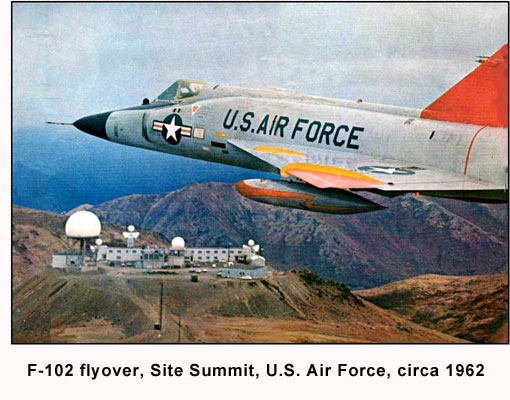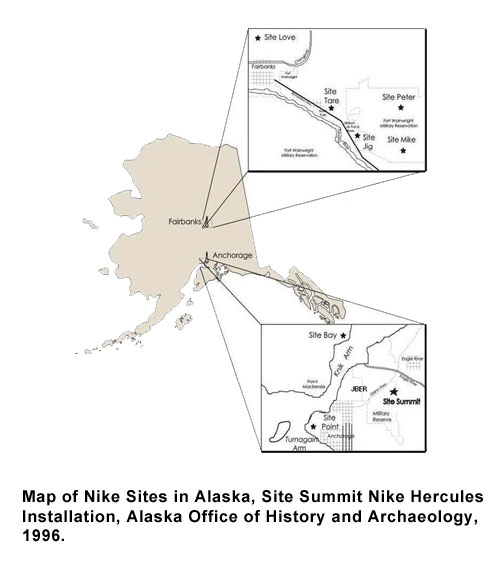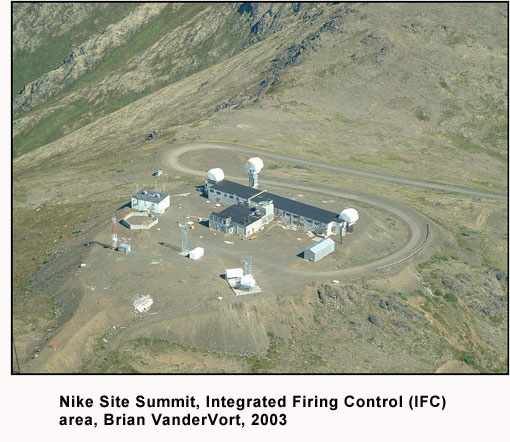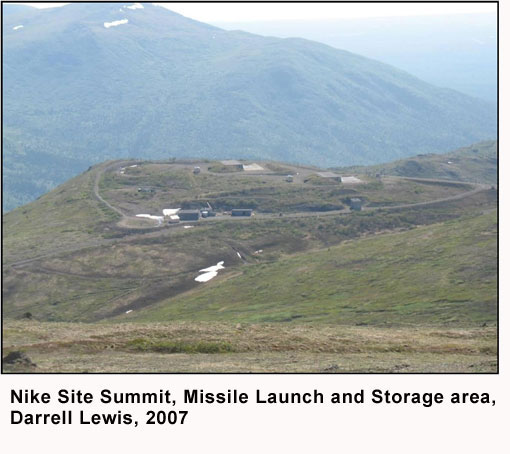Alaska's Role in the Cold War
Alaska, with its close geographic proximity to the Soviet Union, played a critical role in the Cold War. It was America's front line of defense against possible Soviet attacks and was often referred to as "Top Cover for America." Billions of dollars were spent constructing a defense network designed to detect, intercept, and destroy incoming threats.
 The defense network the U.S. military installed in Alaska consisted of two main ground-based radar detection systems and a communications system that linked the radar detection sites to each other, the North American Air Defense Command (NORAD) Alaskan centers, and the headquarters in Colorado. The first ground-based radar detection system in Alaska was the Aircraft Control and Warning system. The AC&W system was constructed between 1951 and 1954 to detect and track potential enemy aircraft and included both coastal and interior sites. The Distant Early Warning (DEW) Line was installed across Alaska from 1955 to 1957. The DEW Line was more reliable and comprehensive than the AC&W system. The DEW Line sites were located farther north than the AC&W sites meaning the Line became the primary early detection system, and the AC&W system functioned as a backup. The White Alice Communications System (WACS), constructed between 1955 and 1959, provided an even more reliable microwave transmission system than the high-frequency radio signals originally used by the AC&W and DEW Line sites. These three systems worked together to alert fighter-interceptors or surface-to-air missile systems of a potential threat from Soviet bombers.
The defense network the U.S. military installed in Alaska consisted of two main ground-based radar detection systems and a communications system that linked the radar detection sites to each other, the North American Air Defense Command (NORAD) Alaskan centers, and the headquarters in Colorado. The first ground-based radar detection system in Alaska was the Aircraft Control and Warning system. The AC&W system was constructed between 1951 and 1954 to detect and track potential enemy aircraft and included both coastal and interior sites. The Distant Early Warning (DEW) Line was installed across Alaska from 1955 to 1957. The DEW Line was more reliable and comprehensive than the AC&W system. The DEW Line sites were located farther north than the AC&W sites meaning the Line became the primary early detection system, and the AC&W system functioned as a backup. The White Alice Communications System (WACS), constructed between 1955 and 1959, provided an even more reliable microwave transmission system than the high-frequency radio signals originally used by the AC&W and DEW Line sites. These three systems worked together to alert fighter-interceptors or surface-to-air missile systems of a potential threat from Soviet bombers.
Nike Hercules in Alaska
The main surface-to-air missile defense system that stood guard over the United States during the Cold War was the Nike system. The Nike Hercules system was a ground-based, anti-aircraft missile defense system. The Nike Ajax missile was the first generation Nike missile. It was developed immediately after World War II and used until the late 1950s. The second generation, Nike Hercules, missile began replacing the smaller Nike Ajax missile in 1958. Most Nike Hercules missiles were installed at retrofitted Nike Ajax missile sites. Of the 145 Nike Hercules sites in the United States only 35, including those in Alaska, were newly constructed sites..
Eight Nike Hercules sites were constructed in Alaska between 1957 and 1959, five in the Fairbanks area and three in the Anchorage area. Site Summit sat atop Mount Gordon Lyon protecting Fort Richardson, Elmendorf Air Force Base, and the city of Anchorage. Site Point was situated on the coast at what is now Kincaid Park. Site Bay was located across the Knik Arm from Anchorage, near Goose Bay. Sites Love, Tare, Jig, Peter, and Mike protected Fairbanks. The Alaskan Nike sites were used the longest, staying operational until 1979 when they were deactivated because the system was no longer needed. A new threat had arisen - the Intercontinental Ballistic Missile - and new technology was needed to address it.
Today, most of these sites have been partially or completely demolished. Because of strong public support for its preservation, Nike Site Summit has been spared from demolition. In 1996, Site Summit was listed in the National Register of Historic Places as an historic district, a remarkably well-preserved example of a Nike Hercules missile installation. The historic district is a nationally significant site because of its exceptional importance as a key Army installation for detecting and deterring enemy aircraft and for its role in test firing missiles during the Cold War. It is also significant because of its unique, subarctic technical designs.

Nike Site Summit
Site Summit was built as a small, self-contained community high above Anchorage, Fort Richardson, and Elmendorf Air Force Base, Alaska. Because of its location high atop Mount Gordon Lyon in the Chugach Mountain Range, Site Summit had its own power, water, and fuel supplies. This mountaintop location also meant harsh weather conditions. Soldiers living at the site were regularly exposed to high winds, fog, excessive snow, and extreme temperatures. To protect equipment, make maintenance easier, and protect the Soldiers from the harsh environment, living quarters, mechanical areas, shops, and work rooms were all located within a single building.
Site Summit was divided into two areas: the Integrated Fire Control area - also called the Battery Control area - and the Missile Launch and Storage area. The IFC area was located on the 3,900-foot peak of Mount Gordon Lyon. Sixty vertical feet of the mountain peak were blasted off to make a level construction area. It consisted of a single building containing the barracks, mess hall, PX, offices, and mechanical/power equipment. It also included the radars and communication equipment that were used to identify and track enemy aircraft and to guide the missiles to their targets.
 The Missile Launch and Storage area was located approximately 5,000 feet south of the IFC area at the 3,100- foot level of the mountain. This is where the missiles were stored, maintained, and launched. It contained the launch and storage buildings, launch pad, launch control building, facilities for guided missile maintenance, and the guard dog kennels. One feature of the Missile Launch and Storage area that was unique to Alaskan Nike sites was the aboveground launch buildings. In other states, the launch control buildings were built underground because of land constraints. The launch pads were located on top of the buildings, and the missiles would be raised to the launch pads by means of elevators. In Alaska, land was widely available and permafrost made construction of subterranean structures problematic, so the launch buildings were built above ground. The IFC and Missile Launch and Storage areas were connected by a winding road approximately two miles long. A personnel vehicle shuttled Soldiers between the two areas.
The Missile Launch and Storage area was located approximately 5,000 feet south of the IFC area at the 3,100- foot level of the mountain. This is where the missiles were stored, maintained, and launched. It contained the launch and storage buildings, launch pad, launch control building, facilities for guided missile maintenance, and the guard dog kennels. One feature of the Missile Launch and Storage area that was unique to Alaskan Nike sites was the aboveground launch buildings. In other states, the launch control buildings were built underground because of land constraints. The launch pads were located on top of the buildings, and the missiles would be raised to the launch pads by means of elevators. In Alaska, land was widely available and permafrost made construction of subterranean structures problematic, so the launch buildings were built above ground. The IFC and Missile Launch and Storage areas were connected by a winding road approximately two miles long. A personnel vehicle shuttled Soldiers between the two areas.